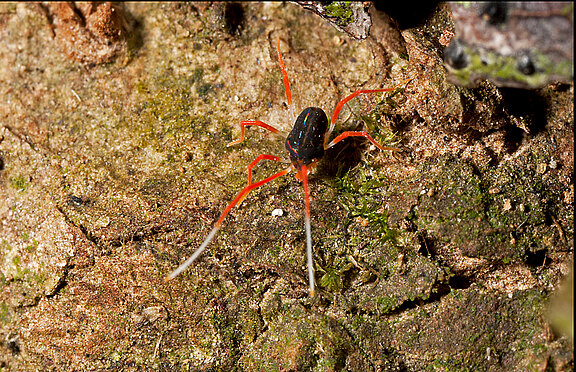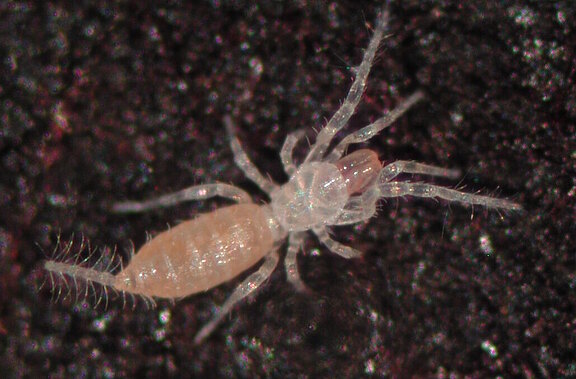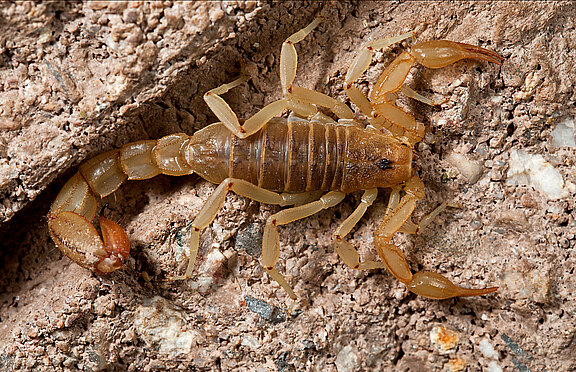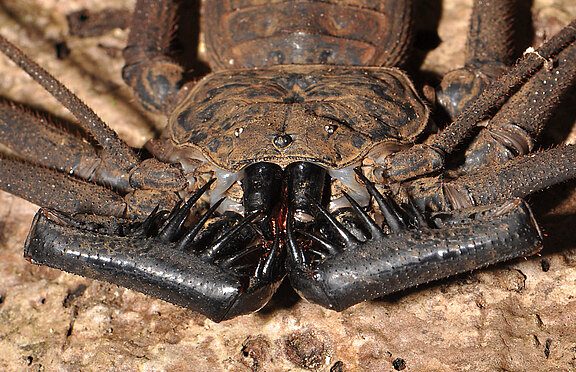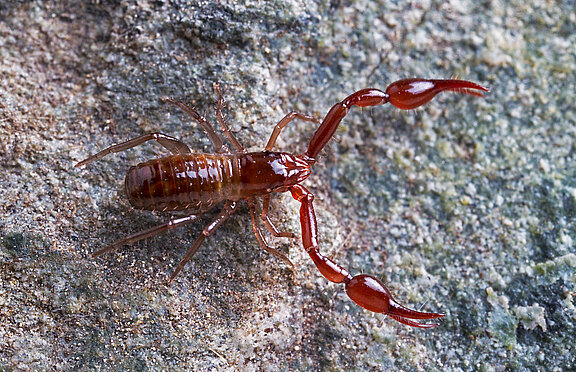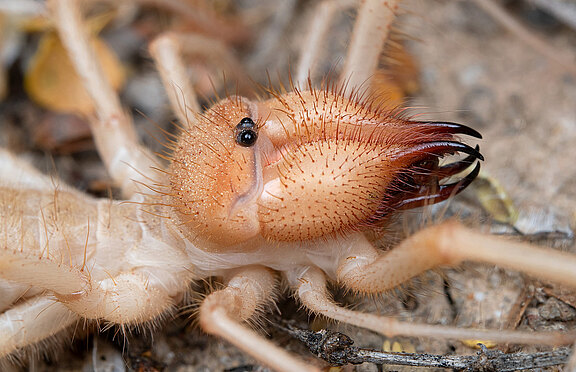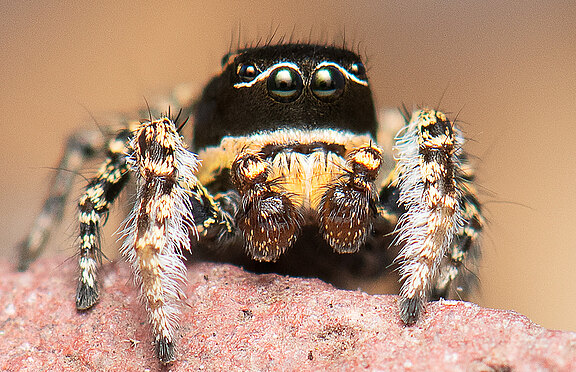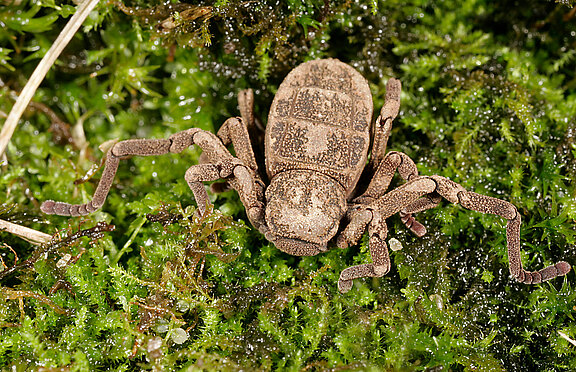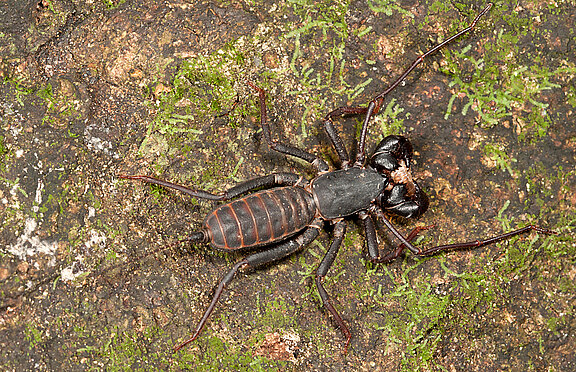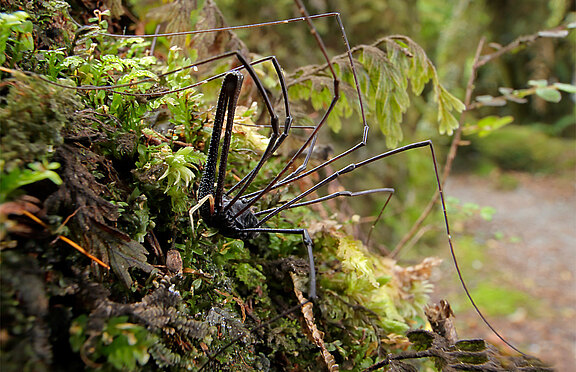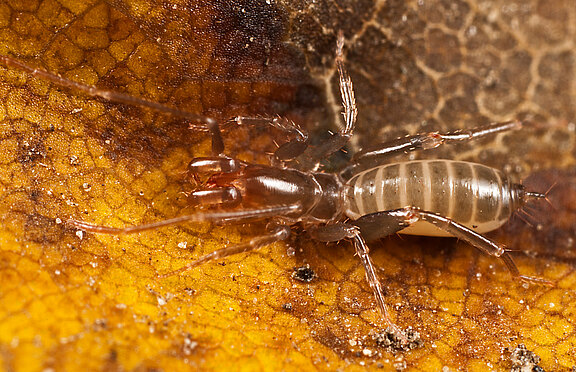Harriet Exline Frizzell

Harriet Exline Frizzell, An Appreciation of Her Life and Work
By William B. Peck
Published in American Arachnology, February 1969
The wit and wisdom, the generous eagerness to help, and the unassuming dignity that many of us knew in Harriet Frizzell were as much a part of her as her dedication and devotion to spiders and science. But it was her warm acceptance and genuine appreciation of humanity that really endeared her to colleagues, friends, and acquaintances alike. Her death in February, 1968, cannot diminish the influence that she left upon her chosen science nor upon the many people with whom she associated.
Harriet’s long career in araneology had a rather casual beginning she always claimed. She had entered Reed College at the age of sixteen planning to study language and literature but was lured into the sciences by a burgeoning interest in chemistry and biology. According to her own account, an advisor suggested that an investigation in spider taxonomy would be an appropriately lady-like undertaking for an undergraduate thesis problem and thereupon launched a lifetime interest. She often remarked, when beset with some taxonomic problem, that she struggled alone with spiders for more than six years before she ever met another person who was seriously involved with a similar study.
With typical modesty she also insisted that her entry into graduate study was simply a matter of circumstance. A graduate assistantship carrying a stipend was merely the most attractive opportunity available during the depression years of the early 1930s. These casual beginnings of a scholarly career that she professed seemed rather unlikely to those of us who were exposed to her brilliantly analytic, scientific attitudes in later years. The depth and breadth of knowledge and wisdom which perforce showed through the simplicity of her characteristic demeanor tended to suggest that there was more direction in her life plan than she cared to admit.
The six years that she spent in graduate study at the University of Washington, with summers at Friday Harbor Biological Station, seem to have been especially rewarding for her personally. They provided an opportunity to continue and expand her spider studies in a region in which the fauna was then virtually unknown. She also published a paper on the pycnogonids of Puget Sound during this time. After completing her PhD in 1936, she was awarded the Sterling Fellowship at Yale to pursue postdoctoral research in arachnology with Professor Petrunkevitch, apparently the first woman ever to have received this fellowship. She and “Pete” had much in common beyond arachnids and became lifelong friends. After his death in 1964, she undertook to organize and edit his unpublished notes and manuscripts, and the results of these efforts are pending publication.
In 1938, Harriet was married to Don L. Frizzell, a fellow scientist, in Guayaquil, Ecuador, and the couple remained in Ecuador and Peru for the next five years, individually and jointly continuing their research interests in arachnology and paleontology. After a brief return to the University of Washington to teach navy premedics during World War II, she rejoined her husband who had accepted a place on the staff of the University of Texas. Harriet worked as guest researcher in spiders in the Department of Zoology during their three years in Austin.
The Frizzells moved to the University of Missouri at Rolla in 1948, and thereafter Harriet continued her spider research largely independently. With typical devotion to their work, the Frizzells modified their home to provide a separate laboratory in it for each of them and to accommodate an underground, concrete vault in which Harriet could safely store the vast spider collection that she had accumulated through the years. Though working independently, she was at this time named a Fellow and Research Associate of the California Academy of Sciences, an association which she continued until her death. She was also appointed taxonomist and consultant for a National Science Foundation project in spider biology conducted at the University of Arkansas from 1960 to 1967.
Although spiders were Harriet’s first and consuming love and she devoted enormous amounts of her time to encouraging and helping whoever showed the faintest interest in them, her other interests and activities were diverse and many. She was an inveterate gardener who was neither dismayed nor hampered by adverse weather or recalcitrant soil. She was continually frustrated from April to October, however, because a mere 24 hours a day was an entirely inadequate amount of time for the proper care of both her flowers and spiders. And still, in her resourcefulness, she could find time to attend garden club meetings and most of the concerts, recitals, and art exhibits that were available, to trade her plants and specially prepared dishes with neighbors and friends, to commiserate and counsel with lonely or disoriented students, to make pickles and can vegetables, to attend to the needs of her assortment of semi-domesticated cats, to read all the new “who-done-its” and to go fishing.
She also carried on a voluminous correspondence with arachnologists throughout the world, made innumerable gifts and loans from her collection continually, and served as Correspondent to the Centre International de Documentation Arachnologique. But all the while she firmly maintained that she was first a wife and a home-maker, and only somewhat as an after-thought, a sometime contributor to the expanding realm of knowledge.
Aside from the loss that araneology will suffer by her death, we who knew her have also suffered a deep personal loss. Such was her personality that each of us must like to think that he had a special and privileged place in her affection. And no doubt we did. So great were her energies, compassion, and generosity that she could and did embrace us all.
Bibliography of Harriet Exline (1909 – 1968)
1934. (and Hatch). Note of the food of the black widow spider. J. New York Entomol. Soc. 42:449-450.
1935. Three new species of Cybaeus. Pan-Pacific Entomol. 11(3):129-132.
1936. A new species of Cybaeus. (Araneae: Agelenidae). Entomol. News. 46(10):275-286.
1936. Pycnogonids from Puget Sound. Proc. U.S. Nat. Mus. 83(2991):413-422.
1936. New and little known species of Tegenaria (Araneida: Agelenidae). Psyche 43(1):21-26.
1936. Nearctic spiders of the genus Cicurina Menge. Am. Mus. Novitates 850:1-22.
1937. The Araneida of Washington: Pholcidae, Argiopidae, Agelenidae, Hahniidae, Attidae. Univ. Washington Publ. Theses Ser. 2:717.
1938. Gynandromorph spiders. J. Morph. 63(3):441-472.
1938. The Araneida of Washington: Agelenidae and Hahniidae. Univ. Washington Publ. Biol. 9(1):1-44.
1939. (and Petrunkevitch). List of species, suborder Mygalomorphae. In: Pentrunkevitch, 1939. Catalogue of American spiders. Trans. Connecticut Acad. Arts. Sci. 38:191-338.
1945. A new group of the genus Conopistha Karsch, 1881. Trans. Connecticut Acad. Arts. Sci. 36:177-190.
1945. Spiders of the genus Conopistha (Theridiidae, Conopisthinae) from northwestern Peru and Ecuador. Ann. Entomol. Soc. Am. 38(4):505-528.
1948. Morphology, habits and systematic position of Allepeira lemniscata (Walckenaer) (Araneida: Argiopidae, Allepeirinae). Ann. Entomol. Soc. Am. 41(3):309-325.
1950. Conopisthine spiders (Theridiiae) from Peru and Ecuador. In: Studies Honoring Trevor Kincaid. Univ. Washington Press. Pp. 108-124.
1950. Spiders of the Rhoicininae (Pisauridae) from Western Peru and Ecuador. Am. Mus. Novitates 1470:1-13.
1951. Tegenaria agrestis (Walckenaer), a European agelenid spider introduced into Washington State. Ann. Entomol. Soc. Am. 44(3):308-310.
1955. (with D. L. Frizzell). Micropaleontology of holothurian sclerites. Micropaleontology 1(4):335-342.
1956. (with D. L. Frizzell). Monograph of fossil holothurian sclerites. Univ. Missouri, School Mines & Metallurgy Bull., Tech. Ser. 89:1-204.
1957. (with D. L. Frizzell). Holothurians. In: Ladd, H. S. (editor), Treatise on Marine Ecology and Paleoecology. Geol. Soc. Am. Mem. 67:983-986.
1957. (with D. L. Frizzell). Revision of the family Synaptitidae, fossil holothurian sclerites (Echinodermata, Holothuroidea). Soc. Geol. Peru Boletin 32:97-119.
1958. (with D. L. Frizzell). Crustacean gastroliths from the Claiborne Eocene of Texas. Micropaleontology 4(3):273-280.
1958. (with D. L. Frizzell). Fish ossiculiths: unrecognized microfossils. Micropaleontology 4(3):281-285.
1960. Rhocinine spiders (Pisauridae) of Western South America. Proc. California Acad. Sci. 4th Ser. 29(17):577-620.
1962. (and Levi). American spiders of the genus Argyrodes (Araneae: Theridiidae). Bull. Mus. Comp. Zool. 127(2):75-204.
1962. Two gnaphosid spiders from Arkansas. Proc. California Acad. Sci. 4th Ser. 32(4):70-85.
1963. (and Whitcomb and Hite). Comparison of spider populations of the ground stratum in Arkansas pasture and adjacent cultivated field. Arkansas Acad. Sci. Proc. 17:1-6.
1963. (and Whitcomb and Hunter). Spiders of the Arkansas cotton field. Ann. Entomol. Soc. Am. 56:653-660.
1965. (and Levi). The spider genus Synotaxus (Araneae: Theridiiae). Trans. Am. Micros. Soc. 84(2):177-184.
1965. (and Whitcomb). Clarification of the mating procedure of Peucetia viridans (Araneida: Oxyopidae) by microscopic examination of the epigynal plug. Florida Entomol. 48(3):169-171.
1966. (with D. L. Frizzell). Holothuroidea – Fossil record. In: Moore, R. C. (editor), Treatise on Invertebrate Paleontology. (Univ. Kansas – Geol. Soc. Am.) vol. 2:646-672.
Notes that accompanied Peck’s Exline Obituary apparently from a Mary Margaret who was close to Harriet [transcribed by Paula E. Cushing, 2016]
Harriet: Did not, because of ill health, begin a formal education until she was eight years old. When she finally started school she entered the fifth grade and was graduated from high school when she was 15. She read Hiawatha through at the age of three.
When she entered Reed College in 1926 (I think) she planned to be a language and literature major. Her work in these fields was excellent, but she became interested in chemistry in her junior year and was encouraged to major in that subject. Meanwhile she had also become interested in biology and the professor whom she had in this subject managed to get her to assist him in his pet project of arachnology (sp?). Once she became involved in this she decided to use zoology as a major and received her B.S. degree in 1930 (I think, again).
She received a fellowship in zoology for the following year at the U. of Washington, Seattle, and there she worked on spider research and taught under Dr. Trevor Kincaid (a fabulous man, who by the way, is still living). He and Harriet were both eccentrics and made an interesting and very successful teaching team. Dr. Kincaid gave wonderful lectures and Harriet was a fine laboratory assistant. I don’t recall how many years she was at the U. of W. but it was while there that she married Lowell Lloyd who received his PhD degree in parasitology. Meanwhile Harriet took her doctorate at the U. and I remember that it was said by the Dean of the Graduate School (I think!) who was one of the team of professors who sat in on her oral examinations that she passed them far better than any woman who had taken them previously at that institution.
Lowell died shortly after they were married and Harriet accepted the Sterling Scholarship to continue in “spider” (I just can’t spell that other big word [arachnology] so use this layman’s phrase) research under Dr. Petronkavitch [sic] – (awk! Bill, you’ll just have to supply the spelling for these references if you decide to use any such material. I’m way out of my element.) I think I am correct in saying that this was the first time that the Sterling Scholarship had been offered by Yale University to a woman.
After completing her year at Yale she married Don [Frizzell] in Quito, Ecuador, or was it Guayaquil? And how does one spell these names? (I should “of took” Spanish). She lived also in Peru as you know at the compound for the International Petroleum Company at Talara, which, by the way, has now been taken over by the government of Peru. During World War II she returned to the States and taught the V-12 program at the U. of W. It was a program sponsored by the Navy for their budding medics and Harriet told her students that she might have to have her appendix removed someday by one of them after he had become a full-fledged doctor and she wouldn’t feel in safe hands unless he had gained a solid background in pre-medic vertebrate zoology under her tutelage. We have met some of these stud former students occasionally in later life and they did learn their zoology if nothing else.
Sometime after this, Harriet joined Don in Austin, Texas where he had accepted a teaching position with the U. and then they later moved to Rolla. Harriet, (when I was with her in the summer of 1967) after talking it over with me, decided to apply for a teaching job in biology that year or the next, probably, I presumed with the U. of Mo. at Rolla. I believe it was planned to open a biology department there and it was my impression that Harriet was seriously considered as a professor in the new department. Actually, I think she had been offered the position if the opening occurred, but since I am not certain I suppose it would not be wise to mention this – and you likely would not find a place for such kind of information anyhow. The only reference might be to the fact that she had planned to become even more active in her profession.
This is awful, Bill, but I am in a hurry; don’t remember much of any facts that you would want to know; and am terribly ignorant about scientific (or for that matter any other) material. All I can really remember accurately about Harriet had to do with facets of her personality that hardly have a place in a scientific publication.
-- MM [initials likely stand for someone named Mary Margaret since part of a letter signed by her is included in the same packet]
P.S. While we’re on the subject of Harriet’s background and just as a point of interest to you, the name “Exline” was probably of both French (Axeline) and German (Oschlein) origin. The family (Harriet and I) are direct descendants of Willian? Schuster who served as personal aide to George Washington in the Revolutionary War. Gen. Washington, gave as a gift for Schuster’s services, a section of land in southern Ohio to him and to each of his ten children

